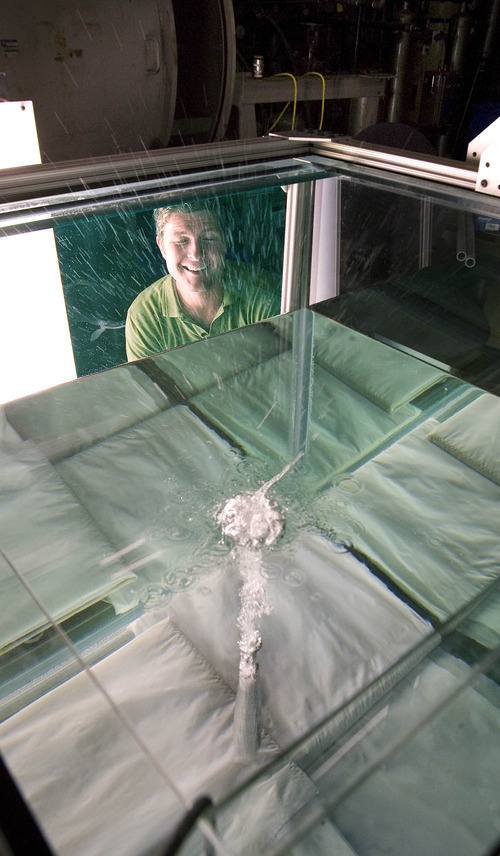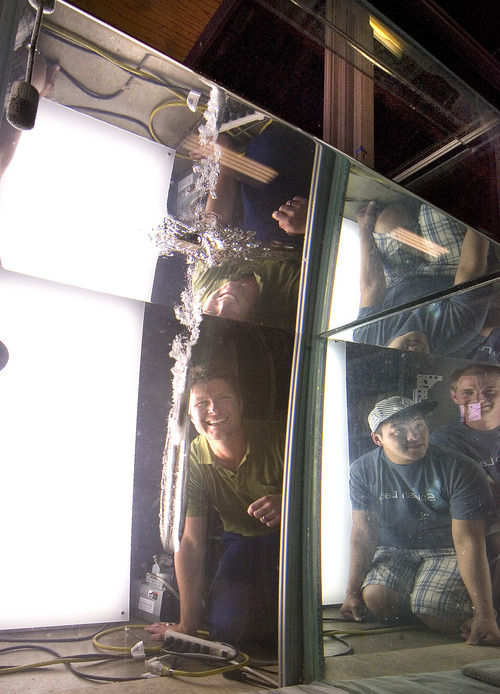This is an archived article that was published on sltrib.com in 2012, and information in the article may be outdated. It is provided only for personal research purposes and may not be reprinted.
Provo • Ever wonder what causes the sound of an object hitting water, what makes a stone skip well or why a small ball zigzags as it rises through water? On any summer day at a public pool you'll see kids exploring these riddles of nature, bouncing toys across the surface and trying to get balls to pop high into the air.
In engineering professor Tadd Truscott's lab, games like these are serious science, where the Navy and National Science Foundation fund his students' studies of what happens when moving objects come into contact with fluids.
Their findings will surprise you.
In an anonymous building on Brigham Young University campus, known as B-38, Truscott runs Splash Lab. Aided with high-speed cameras, elaborate data-recording devices and computer algorithms, his team of mechanical-engineering students is reordering our understanding of everyday phenomena — such as skipping stones and spheres rising in water.
For example, if you swat the top of a water-filled beer bottle just right with a mallet, the bottom of the bottle will blow out. The rupture comes from the impact, right? Wrong.
Graduate student Jesse Daily's video of this experiment, played in super-slow motion, shows bubbles forming at the bottom of the bottle as the impact drives the bottle downward. Then the mystery bubbles collapse in a millisecond as cracks propagate from the base. (This trick, which should only be attempted using gloves and eye protection, does not work if the bottle is filled with a carbonated beverage.)
"We take some seemingly ordinary things and some not-so-ordinary things and evaluate their behavior very carefully. We measure them with all kinds of instruments and cameras. This part of the work is already very difficult because everything has to be timed just right," says Truscott, an affable assistant professor whose enthusiasm for fluid dynamics is nothing short of infectious.
"We also try to tell the story in a compelling way that keeps the non-scientist and children interested, so that we can have some impact on them and their future."
The team has yet to publish findings on the exploding bottle, but they theorize that the collapsing bubbles create a powerful water jet and the downward thrust is what breaks the bottle.
Why are the bubbles even forming? Daily suspects the bottle's movement reduces pressure on the water so rapidly it momentarily vaporizes as if it were boiling.
No one could see these bubbles, whose existence spans all of about one-hundredth of a second, were it not for cameras that record at 1,000 or more high-resolution frames per second and the computing power to crunch mass quantities of data.
Splash Lab generated a terabyte, or 1,000 gigabytes, last year and expects to generate another 1.5 terabytes this year.
Truscott's interest in this science arose from his passion for sailing on Utah Lake and the Great Salt Lake as a youngster. The 2003 University of Utah graduate went on to MIT for his doctorate, then returned to his native Utah as a BYU professor in 2010.
In school, he wanted to design high-performance sailing vessels, but his experiments firing bullets into water caught the attention of the Office of Naval Research and his academic career was propelled in a new direction.
Back at B-38, grad student Kyle Bodily is preparing another experiment in which the team drops a torpedo-shaped object from varying heights into a transparent tank of water. The team records video of the projectile's descent from two angles, as well as audio, and recovers measurements of the projectile's speed and movements on three axes.
They use computer programs to synchronize all this data. The goal is to devise mathematical formulas to characterize how the projectile moves at different speeds and when covered with water-adhering or water-repelling coatings.
Truscott is not privy to what the Navy does with his findings, but it's a safe bet that this branch of the military is interested in improving the control, efficiency and stealth of water-based weapons systems.
As a graduate student Truscott became intrigued with — among other things involving food and fluids — spinning hardboiled eggs in spilled milk. The white fluid travels up the side of the egg, then flings off when it reaches the equator, or the fattest part of the egg.
His students tackled the mystery in Splash Lab, hoping to explain why fluid travels up the surface of a spinning sphere. Ken Langley found that spin speed dramatically alters the way the liquid flings off. At slow speeds, it comes off in sloppy drops, which turn to jets at higher speeds. Spin an egg-sized orb fast enough and it comes off in a sheet. The thicker the fluid, the wider the sheet, reaching several feet in diameter.
The team was able to predict flow rates based on the size and speed of the rotating sphere and the viscosity of the fluid. This knowledge could be useful in designing new types of pumps, Truscott says.
But for his students, the science behind the rising fluid is just plain interesting. And it makes for beautiful pictures. —
More on the Web
The National Public Radio program Science Friday has produced a video of the spinning orb experiments in Splash Lab. Find it and a BYU video explaining how rocks skip at http://www.sltrib.com.











